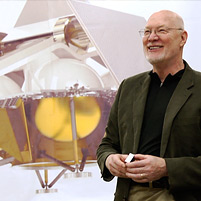Assembly Complete

William "Red" Whittaker
Astrobotic Technology Inc. and Carnegie Mellon University researchers have completed structural assembly of their lunar lander.
The craft will deliver the Red Rover robot to the moon in 2014 — as part of the Google Lunar X competition.
The half-ton aluminum structure will now undergo shake testing to confirm its soundness and its compatibility with the SpaceX Falcon 9 launch vehicle.
Astrobotic plans to land the spacecraft — carrying both the robot and a commercial payload — on the moon's Sea of Tranquility or on the Marius Hills.
The solar-powered Red Rover will broadcast high-definition video to Earth as the four-wheeled robot explores the moon.
Carnegie Mellon University is competing in for the Google Lunar X Prize — a $30 million competition for the first privately funded team to send a robot to the moon, travel 500 meters and transmit video, images and data back to Earth.
Carnegie Mellon's team will do all that and more — bringing art to the moon and creativity beyond the Earth's domain.
Astrobotic aims to claim up to $36 million in awards from the Google Lunar X Prize, a NASA landing contract and a Florida launch bonus.
"This lunar lander will be a key part of our initial moon mission and we expect to re-use this design for a series of missions that will establish Astrobotic Technology as an ongoing, exploration enterprise," said William "Red" Whittaker, CMU professor of robotics and Astrobotics' CEO and chief technical officer.
"It's an amazing piece of technology, and it's gratifying to know that so much of it was invented and crafted here in Western Pennsylvania."
The team used engineering simulation software provided by ANSYS Inc. of Canonsburg, Pa., to calculate the design's strength and stiffness.
Pittsburgh-based Alcoa provided technical expertise, the aluminum used to create the structure of the lunar lander, and the fasteners that hold the lander together.
Its largest component is a 10-foot-diameter, 1-inch-thick deck made from two slabs of solid aluminum joined via stir welding by Concurrent Technologies Corp. in Johnstown, Pa., and machined by Edgar Industries in New Kensington, Pa.
Assembly took place in the Planetary Robotics Lab in Carnegie Mellon's Gates and Hillman centers; a grant from the state of Pennsylvania enabled construction of the lab, which was finished in 2009.
In February, Astrobotic signed a contract with SpaceX to launch its mission on a Falcon 9 rocket, the same vehicle that NASA will use to send supplies to the International Space Station.
The Falcon 9 will throw the Astrobotic spacecraft into a lunar trajectory for a four-day cruise to the moon.
Navigation software, developed at Carnegie Mellon's Robotics Institute so vehicles could drive themselves safely and reliably, will be used to guide the spacecraft to a soft and precise landing on the moon.
A unique aspect of the expedition is the inclusion of interdisciplinary arts projects created by students and faculty based in the STUDIO for Creative Inquiry at Carnegie Mellon's College of Fine Arts.
CMU Professor Lowry Burgess is coordinating the historic Moon Arts project.
In addition to Carnegie Mellon, the mission is supported by industrial partners such as International Rectifier Corporation and corporate sponsors such as Caterpillar Inc.
Related Links: Google Lunar X Prize | Astrobotic Technology | Eyes on the Prize | Robotics Institute | SCS
